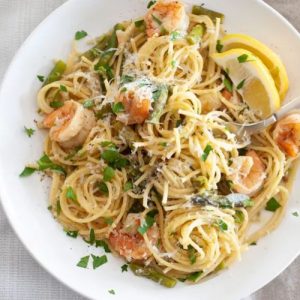
Shrimp and Asparagus Pasta
A quick, healthy, and flavorful pasta dish featuring succulent shrimp, crisp asparagus, and spaghetti tossed in a light lemon-garlic sauce. Perfect for a weeknight dinner, this high-protein, fiber-rich recipe is ready in just 35 minutes.
Equipment
- 1-Large pot
- 1-Colander
- 1 Dutch oven or large skillet
- Measuring Cups and Spoons
- Knife and cutting board
- Tongs or wooden spoon
Ingredients
- 12 ounces spaghetti
- 3 tablespoons olive oil
- 1 yellow onion diced
- 1 pound medium-large uncooked shrimp 21/25 per pound, peeled and deveined
- 1 bunch medium-sized asparagus trimmed and cut into 1-inch pieces
- 4 cloves garlic minced
- ½ teaspoon kosher salt plus more to taste
- ¼ teaspoon freshly ground black pepper plus more to taste
- ½ cup dry white wine
- 3 tablespoons unsalted butter divided
- 1 lemon juiced
- ¼ cup Parmesan cheese grated
- 4 teaspoons flat-leaf parsley chopped
- 4 lemon wedges for serving
Instructions
- Prepare Pasta Water: Fill a large pot with water and add a generous amount of salt—it should taste slightly like the sea. Place the pot over high heat and bring the water to a rapid boil. Salting the water not only seasons the pasta but also enhances its natural flavor. While waiting for the water to boil, gather the rest of your ingredients and prepare them for cooking.
- Cook Pasta to Nearly Al Dente: Once the water reaches a rolling boil, add the spaghetti carefully, stirring immediately to prevent sticking. Cook according to the package instructions but stop one minute before the recommended time. The pasta should be tender yet slightly firm at the center. This will allow it to finish cooking when combined with the shrimp and sauce later, absorbing the flavors without becoming mushy.
- Reserve Pasta Water: Before draining the pasta, carefully scoop out one cup of the hot pasta water and set it aside. This starchy water is essential for creating a smooth, cohesive sauce later. Then, drain the pasta in a colander, shaking off any excess water, but don’t rinse—the residual starch will help the sauce adhere to each strand.
- Sauté Onions for Aroma: In a Dutch oven or large skillet, heat 3 tablespoons of olive oil over medium-high heat until shimmering. Add the diced yellow onion and stir frequently for about 3 minutes until it softens and becomes slightly translucent. This step releases the onion’s natural sweetness and forms a flavorful base for the shrimp and asparagus.
- Cook Shrimp and Asparagus: Increase the heat to high and add the uncooked shrimp, asparagus pieces, and minced garlic to the onions. Stir gently but consistently, allowing the shrimp to cook evenly. Within approximately 4 minutes, the shrimp should begin turning pink on the sides, signaling that they are nearly done. The asparagus should still retain some crunch, creating a delightful texture contrast. Season lightly with 1/2 teaspoon salt and 1/4 teaspoon black pepper.
- Deglaze with White Wine: Reduce the heat slightly to medium and pour in 1/2 cup dry white wine. Add 2 tablespoons of butter to the pan as well. Stir gently, scraping the bottom of the pan to lift any browned bits, which adds depth to the sauce. Let the mixture simmer for 2 minutes to reduce slightly, concentrating the wine’s flavor while blending it with the butter and aromatics.
- Add Lemon Juice and Final Seasoning: Squeeze the juice of one lemon directly into the pan, stirring to combine. Taste the mixture and adjust the seasoning with additional salt and pepper as needed. Allow the sauce to continue cooking for 2 more minutes, ensuring the asparagus is tender but still crisp and the shrimp are fully opaque and perfectly cooked.
- Combine Pasta with Sauce: Add the drained spaghetti to the pan along with 1/2 cup of the reserved pasta water and the remaining 1 tablespoon of butter. Using tongs or a large spoon, gently toss the pasta with the shrimp, asparagus, and sauce. Cook for an additional 1–2 minutes, until the pasta absorbs some sauce, is coated evenly, and reaches a perfectly tender, slightly firm texture. If the mixture seems dry, gradually add more of the reserved pasta water to achieve a silky consistency.
- Taste and Adjust Final Flavors: Before serving, taste the pasta once more. Adjust salt, pepper, or lemon juice as needed to ensure a balanced flavor profile. The sauce should be bright, buttery, and lightly garlicky, perfectly complementing the shrimp and fresh asparagus.
- Plate and Garnish: Divide the pasta into four portions, placing it neatly on plates. Sprinkle each serving with grated Parmesan and chopped flat-leaf parsley. Add a lemon wedge on the side for extra zest and visual appeal. This final touch enhances both the flavor and presentation, making the dish look restaurant-quality at home.
- Serve and Enjoy Immediately: Serve the pasta while it’s warm to fully enjoy the tender shrimp, crisp asparagus, and silky sauce. Encourage diners to squeeze the lemon wedge over the dish for a fresh, tangy finish. This meal is not only delicious but also visually appealing, nutritious, and satisfying—a perfect combination of quick weeknight convenience and gourmet flair.
Notes
- Use fresh, high-quality shrimp for the best flavor and texture. Medium-large shrimp (21/25 per pound) are ideal for even cooking.
- Trim asparagus carefully and cut into uniform pieces to ensure they cook evenly with the shrimp.
- Reserve pasta water—it’s a secret ingredient that helps bind the sauce and pasta perfectly.
- Stop cooking the pasta one minute shy of al dente; it finishes cooking in the sauce for optimal texture.
- Taste and adjust seasoning gradually; shrimp and asparagus absorb flavors quickly, so balance is key.
- Lemon juice brightens the dish—add gradually and taste to avoid overpowering the delicate flavors.
- For a lighter version, reduce butter slightly or use olive oil only without sacrificing richness.